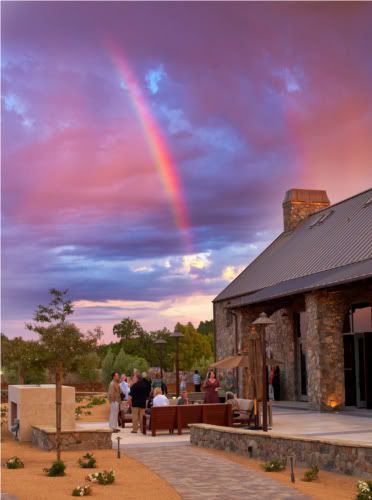
The wine industry boasts many people and companies who would like to make the world a better place. Making great wine for our enjoyment certainly helps in that effort, but there is much more to improving our situation on the planet than knowing how to create a good time in a bottle.
Niner Wine Estates in Paso Robles has gone above and beyond the call of wine, at least according to the U.S. Green Building Council. Niner's state-of-the-art facility has been honored with the organization's LEED Silver Certification. This makes Niner one of only four wineries in California - and the first in the Central Coast AVA - to be recognized in this manner for designing and operating their facility with extreme greenness in mind.
LEED stands for Leadership in Energy and Environmental Design. It's a building rating program, a nationally accepted benchmark for evaluating the design, construction and operation of high performance green buildings. Buildings are certified based on superior performance in energy efficiency, sustainable site development, water efficiency, selection of materials and indoor environmental quality.
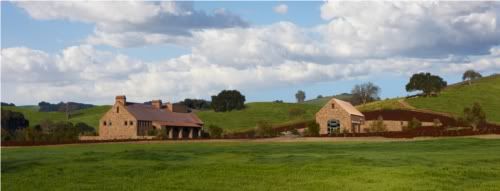 Niner was awarded the LEED Silver Certification for its Paso Robles complex, which includes a Hospitality Center, Demonstration Winery and Production Winery totalling about 75,000 square feet on 140 acres of Westside real estate.
Niner was awarded the LEED Silver Certification for its Paso Robles complex, which includes a Hospitality Center, Demonstration Winery and Production Winery totalling about 75,000 square feet on 140 acres of Westside real estate.
Niner's owners Richard and Pam Niner were over the moon about the certification. According to Rick Fedrizzi, President, CEO and Founding Chair of the U.S. Green Building Council, so was the council. "The work of innovative building projects such as Niner Wine Estates is a fundamental driving force in (the green building) movement," said Fedrizzi.
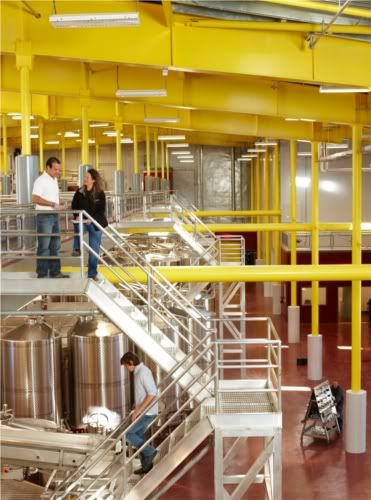 A tour of the facility showed the different facets which allowed Niner to achieve the honor. Niner's enologist, Lorna Kreutz, guided me through the entire Production Winery. She took it all in stride, but I was agog at the pristine conditions I found in the tank room. I guessed that since the place is fairly new, it just hadn't had time to take on a "lived-in" look. "No," said Lorna, "we work pretty hard to keep it looking nice." I spied what looked like a couple of scraps of paper on the floor, but I was wrong again. "Those are actually pieces of tape placed there for measurement purposes," she said. "When the crew is done working, they'll take those up."
A tour of the facility showed the different facets which allowed Niner to achieve the honor. Niner's enologist, Lorna Kreutz, guided me through the entire Production Winery. She took it all in stride, but I was agog at the pristine conditions I found in the tank room. I guessed that since the place is fairly new, it just hadn't had time to take on a "lived-in" look. "No," said Lorna, "we work pretty hard to keep it looking nice." I spied what looked like a couple of scraps of paper on the floor, but I was wrong again. "Those are actually pieces of tape placed there for measurement purposes," she said. "When the crew is done working, they'll take those up."
The building, of course, is not only clean - it's green. It's built into a cut in the hillside to help keep it cool naturally. Insulated concrete walls help with that, too. The cellar has a system which brings in night air, and that also helps reduce cooling needs.
Lorna explained that wastewater is treated and recycled for use as vineyard irrigation, and rainwater is also collected for that purpose.
The building materials are either recycled or locally manufactured, the multi-level design allows gravity to do the work of pumps and even the paint and flooring uses materials which enhance not only the indoor environment, but the one outside as well.
Niner Wine Estates has proven that a technologically advanced facility can also be one that fits well into its surroundings and one that keeps the environment at the forefront. All this comes at some cost. As I poked around various places in Paso Robles, I heard the facility and its "$50 million pricetag" talked about with some pride and, I suspect, some jealousy. I'm sure any winemaker would love to have this kind of winery as a workplace. Niner's winemaker Amanda Cramer should get some of the credit for this design, as she had a hand in creating the Niner winery as a functional wonder of the wine world.
Richard Niner is the visionary here, and he's the guy who put his money where his dreams are. His belief that world class wines are the sum total of great people, great vineyards, great tools and great ideas is the driving force behind Niner Wine Estates.

When you’re tasting a wine at home, it’s always great to be able to pair it with food and find out what it works with, or what it doesn’t.
I often don’t have a nice meal in front of me when I’m evaluating wines, so I end up grabbing a handful of almonds, or fishing an olive out of the jar to have some edible reference point.
Apparently, the folks at Wine Spectator like a little snack food with their wine, too. Wine Spectator School and Triscuit have released the Recipes For Wine Lovers iPhone App. The app allows you to select one of 20 wine-friendly Triscuit recipes. The great wheel of snacks spins around and - clink! - down drops a glass containing just the right wine.
According to the app, for Italian salami and cheese on a Triscuit, select a Cabernet. Hot, sweet, bubbly cheddar on a Triscuit calls for Riesling. Bubbly four-cheese tomato on a Triscuit demands nothing less than Pinot Noir. You get the idea.
If any of the snacks strike your fancy, tap on it and a full screen recipe for that treat appears. Of course, it’s usually not much more instruction than, “take the stuff and put it on a Triscuit, then eat it. With wine."
You can find the Triscuit Small Plates app in the iTunes App Store for free. If you have no iPhone, you access the information by website at the same low price.
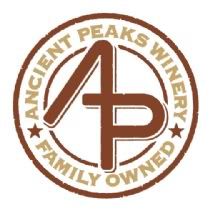
A
trip to Paso Robles, California promised a high level of exposure to people who live and breathe wine. Before my destination arrived, I took the Santa Margarita exit from US Highway 101 and found myself immersed inAncient Peaks Winery.
The Vineyard Tour
It wasn't just a tasting room visit, either. I hopped up into Karl Wittstrom's huge pickup truck and headed for the vineyard, stopping just up the road for a bag of sandwiches to bring along. That's how they do the tour at Ancient Peaks. They get you out of the cozy tasting room and take you where the wine business really happens.
Ancient Peaks is owned as a partnership by three winegrowing families. Karl Wittstrom is one third of that partnership. A towering rancher who knows the vineyards like he knows low gear in that pickup, Wittstrom is a fountain of knowledge about the grapes, the vines, the dirt, the rocks, the mountains, the flora and fauna, the bugs - he knows about everything you can see from any point in his vineyard, and that's a lot. I didn't ask, but I'm sure he could identify every grain of dirt on his dusty floorboard mats.
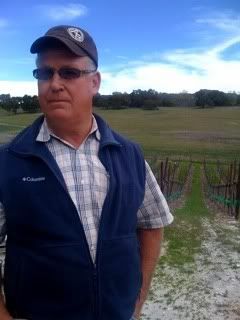 The thing is, you don't have to ask. Karl Wittstrom has all this information ready to spill forth anytime someone looks interested, which I suppose I did.
The thing is, you don't have to ask. Karl Wittstrom has all this information ready to spill forth anytime someone looks interested, which I suppose I did.
His urge to share is so great and his energy so boundless he's the natural choice to guide the tour. At one point he stopped the truck and had me get out to look at a compost station. He turned the mulch with a shovel and stuck his hand in to grab some, so I could see the worms. With boyish enthusiasm he motioned with his head back to the pickup, where my wife was chatting with our companion on the tour. With a complete lack of irony, he asked, "D'ya think she wants to see the worms?" I offered that she could probably skip this lesson, and he continued undaunted, poking the compost with the shovel and explaining how the worms figure into the winegrowing process.
I knew before the tour that there was a lot I didn't know about growing grapes. During the tour, it became increasingly apparent just how much I didn't know.
The People of Ancient Peaks
Wittstrom owns his own family vineyard as well as the partnership vineyards with Ancient Peaks. Doug Filliponi - a longtime local winegrower - oversees all vineyard operations for the winery and Rob Rossi - Ancient Peaks' planning and development guy - is connected in the business side of things.
Mike Sinor - Director of Winemaking - has15 years Central Coast winemaking experience. 2006 was his first full vintage at Ancient Peaks. Amanda Wittstrom-Higgins is the winery's VP of sales and marketing. She's a fifth-generation Paso Robles native.
Growing Grapes
All fruit used by Ancient Peaks comes from their sustainable estate vineyards - SIP certified (Sustainability In Practice) - which allows them to "express the personality of the vineyard."
The different varieties of grapes are allowed to ripen at their own pace.
Vineyard pests are controlled naturally, with a program utilizing boxes as habitats for bats, bluebirds, owls and other predatory birds. No oak trees were removed during the planting of Margarita Vineyard, and wetlands requirements were exceeded.
Margarita Vineyard - sustainably farmed - is the southernmost vineyard in the Paso Robles appellation. It's surrounded by the Santa Lucia mountain range which are the ancient peaks from which the name was taken. It is the only vineyard in the area, and its location in the Santa Margarita Ranch is where grapes were first planted by Franciscan missionaries in 1780.
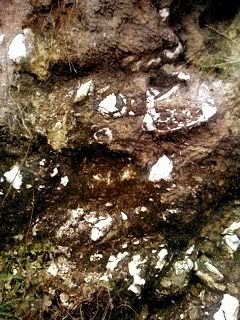 The vineyard features five distinct soil types: ancient sea bed, sedimentary, shale, volcanic and granitic. The folks at Ancient Peaks feel these different soil types bring added dimension and complexity to their wines. Wittstrom delighted in showing off the ancient oyster shells which are imbedded in outcroppings and even scattered about the hillsides of the vineyard.
The vineyard features five distinct soil types: ancient sea bed, sedimentary, shale, volcanic and granitic. The folks at Ancient Peaks feel these different soil types bring added dimension and complexity to their wines. Wittstrom delighted in showing off the ancient oyster shells which are imbedded in outcroppings and even scattered about the hillsides of the vineyard.
Wittstrom concluded the tour by taking us through the rest of the historic Santa Margarita Ranch property dotted with old barns, old things in storage and even an old train built by Walt Disney in 1955. There's history everywhere you look. The train still functions, and they crank it up now and then for special events.
The Wines
Back in the cozy confines of the Ancient Peaks tasting room, we were poured through the wine list. The Ancient Peaks wines are exceptional, each one of them. Most of their wines are in the $14 to $17 price range, with the exception of the Malbec and the Petit Verdot, which sell for $35.
 Sauvignon Blanc 2010 - Grapes from the cool-climate Margarita Vineyard are augmented by a bit of fruit from San Juan Vineyard, in the eastern portion of the Paso Robles AVA. Grass and minerals dominate the expressive nose and the steel-fermented wine is crisp and refreshing with a very nice acidity.
Sauvignon Blanc 2010 - Grapes from the cool-climate Margarita Vineyard are augmented by a bit of fruit from San Juan Vineyard, in the eastern portion of the Paso Robles AVA. Grass and minerals dominate the expressive nose and the steel-fermented wine is crisp and refreshing with a very nice acidity.
Rosé 2010 - Great floral and cherry notes highlight this stainless steel pink made of Pinot Noir from Margarita Vineyard.
Blanco 2010 - Ancient Peaks shows off three of Margarita Vineyard's five soil types in this one.
The Pinot Gris comes from ancient sea bed, the Chardonnay from granitic soil and the Sauvignon Blanc from a sedimentary block. The PG comes on stronger than the Chardonnay, and there's a nice touch of Sauvignon Blanc; minerals galore.
Zinfandel 2008 - Lavendar notes on the nose and a hint of chocolate on the palate make for a delicious experience. The Zin is joined by a splash of Syrah.
Merlot 2009 - This is the variety upon which the brand was founded. Superb minerals play off a cherry/blackberry theme. A bit of help from the Cabs, Sauvignon and Franc.
Cabernet Sauvignon 2009 - Very smooth, and very complex, this Cab has 8% Petit Verdot and 8% Malbec. Cassis and graphite come forward.
Malbec 2008 - One of my favorites here, this wine features a fantastic nose showing traces of violets and chocolate. 8% Syrah.
Petit Verdot 2008 - This 100% varietal wine utilizes grapes from Margarita Vineyard and the warmer climate Wittstrom Vineyard northwest of Paso Robles. It's dark and complicated, with cassis aromas paving the way for a smooth and juicy palate.
Petite Sirah 2008 - The 85% Petite Sirah comes from Karl's personal Wittstrom Vineyard, while 15% is Margarita Vineyard Syrah. A brambly bouquet leads to a dark palate with firm tannins and a caramel finish. This wine carries a 15.7% alcohol number.
Oyster Ridge 2007 - Much of the fruit for this beauty comes from the section of Margarita Vineyard known as Oyster Ridge, the ancient sea bed. Cabernet Sauvignon takes its cues from Petite Sirah, Merlot and Petit Verdot. The nose is big, fruity and floral while the palate shows plenty of minerals. One taste brings the sight of all those oyster fossils into clear focus.

An article in Indiana's Herald Bulletin reveals that Indiana legislators are trying to find new ways to help the Hoosier State's growing wine industry.
When the Indiana Wine Grape Council was created in 1989, it had only nine wineries on the books. Today, Indiana boasts more than 50 wineries in the north and south parts of the state.
The Grape Wine Council says Indiana wineries get 800,000 visitors each year, with the Indiana wine industry adding $33 million to the state's economy.
Indiana wine is seen as a huge benefit for the rural areas where most of the wineries are.
A bill has been introduced which would increase the number of festival permits allowing wineries to serve and sell wine, and it would call on the Indiana Alcohol and Tobacco Commission to study how other states bolster their wine industries.
It may not seem like a very large step, but Indiana, like many states, still has antiquated laws on the books affecting the sale of wine - laws that were put there after Prohibition. Even an Indiana ban on selling wine on Sundays - a law put on the books in 1816 - is still in effect today.
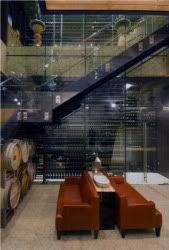
The second annual Stars Of Paso Robles event will be staged twice in Southern California, so wine lovers in Los Angeles and Orange counties will both have access to the pleasures of Paso.
Thursday May 12, 2011 is the date for the Costa Mesa version, while the Beverly Hills soirée is set for the following night, Friday May 13, 2011.
The Costa Mesa event will be held at Charlie Palmer at Bloomingdale's South Coast Plaza. This is fitting, in that the restaurant is themed around wine. The floor is even made from reclaimed wine barrels.
In Beverly Hills, the event will be held outdoors on the cobblestones of the Via Rodeo shopping street at Two Rodeo Drive.
Both wine tasting events will run from 7:00 to 9:30 p.m. on their respective nights and tickets are available for $80 in advance, $150 at the door.
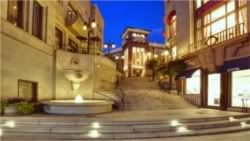 Over two dozen wineries of the Paso Robles AVA are expected to turn out. Names like Cass, Terry Hoage, Hope Family Wines, Turley, Niner and Villa Creek will be joined by hidden gems Roxo Port, Lone Madrone, Alta Colina and Bodegas Paso Robles.
Over two dozen wineries of the Paso Robles AVA are expected to turn out. Names like Cass, Terry Hoage, Hope Family Wines, Turley, Niner and Villa Creek will be joined by hidden gems Roxo Port, Lone Madrone, Alta Colina and Bodegas Paso Robles.
Both events are presented by Learn About Wine, a group dedicated to the appreciation of fine wine and headed up by Ian Blackburn. LAW's Taste and Vintage members receive a discount on tickets.
If you have yet to enjoy an Ian Blackburn wine tasting event, there's no point in waiting any longer. Blackburn is one of Southern California's leading wine educators. He puts winemakers and wine lovers together in an upscale environment and lets the wine do the rest. Always dressed impress, he'll be on hand - as usual - if you'd like to stop and share your thoughts on the wines you are tasting.
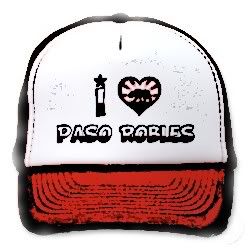
Paso Robles, California is remembered by many as the place actor James Dean had hoped to drive through on his way to Salinas. Dean's life ended 25 miles short of Highway 101 when his speeding sports car collided with Donald Turnupseed's Ford.
Today, that event - monumental at the time - is a footnote in the history of a city which is the center of the fifth largest wine region in California. The Paso Robles AVA comprises two thirds of the Central Coast AVA which contains it. Well over 200 wineries call Paso Robles home, and the number seems to grow every time you check. That fateful intersection of Highways 41 and 46 is memorialized for the legendary car crash which took place there, but in Paso, it's all about the wine.
The Grapes
Paso Robles is most noted for Zinfandel grapes and the wines produced from them, but despite all the festivals held in its honor, Zin actually accounts for only nine percent of the grapes grown there. Cabernet Sauvignon and Merlot cover over half of the pie chart for Paso Robles grape varieties in the AVA's 29,000 acres of vineyards. Over $650 million worth of wine is produced annually in the Paso Robles AVA.
The Layout
Paso - just call it that if you want to sound local - is situated about a half hour north of San Luis Obispo on U.S. Highway 101. The area around Paso Robles is roughly divided into East and West sides, with the freeway as the dividing line. It would be hard to get around in the city and its environs without noticing the wine industry. No matter where you are in Paso, you're near a winery.
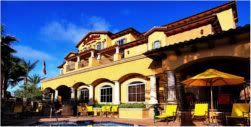 Where To Stay
Where To Stay
If you plan to visit, you are one of 1.2 million tourists who do so each year for Paso wine. There are plenty of hotels, bed & breakfasts and vacation rentals to choose from. I received complimentary lodging at La Bellasera Hotel and Suites for the purpose of this series of articles, and it came highly recommended by everyone I spoke with before the trip. I found it much to my liking, too, and with room rates starting under the $200 mark, I'll check with them first on my next visit.
La Bellasera's Director of Sales Baxter Boyington told me there are over 1250 hotel rooms in Paso Robles. He sang the praises not only of his hotel, but of life in Paso, too. He said returning to his stomping grounds was a distinct pleasure.
As Boyington showed me around the property it was apparent that it's not a huge hotel, but the rooms are clean and outfitted in comfortable elegance, with attention to detail. There are even suites with kitchenettes if your stay is an extended one. A big television in my room never got turned on - no time for TV - but the free WiFi is a must nowadays. A spa and a fitness room offer amenities for those who wish to take a break from wine for a while.
The restaurant at La Bellasera, Enoteca, is appropriately wine-themed and was also on every must-try list I acquired from locals. Steamed clams and mussels are a treat that's hard to pass, and the menu has a number of seafood options, veal, lamb, pork and Angus beef. If you only have time for dessert, try the country style cheesecake or gingerbread creme brulée.
The bar at Enoteca is a favorite hangout for wine people of all stripes. I made new wine friends there, and I'd bet that you will, too - the people in Paso Robles are very friendly. Of course, the wine list at Enoteca is Paso-centric.
Where's The Wine?
As I mentioned, wine is everywhere in Paso Robles. Wineries and tasting rooms abound on the eastside and the west, all the way to the coast. Paso's downtown square just west of the 101 freeway features a number of tasting - and dining - opportunities within easy walking distance.
 One tasting room is interesting in that it serves as a tasting room for six of the smaller local wineries. TheMeritage Wine Tasting Lounge has a large room lined with tasting bars. The night I visited, only four of the winery spaces were staffed, but on weekends you'll find all six wineries represented.
One tasting room is interesting in that it serves as a tasting room for six of the smaller local wineries. TheMeritage Wine Tasting Lounge has a large room lined with tasting bars. The night I visited, only four of the winery spaces were staffed, but on weekends you'll find all six wineries represented.
Meritage hosts Roxo Port Cellars, Line Shack Wine,Brochelle Vineyards, Cerro Prieto, Michaud Vineyardand JK Wine Company, home of the Arada and Katinlabels. When you check in at the front desk you are handed a card which you use at the tasting bars. You can taste a flight or single wines at each of the stations, then settle up at the desk on your way out.
Brochelle Vineyards had a flight of three wines which could be paired with cheeses. I tasted their Grenache/Syrah/Zinfandel Rosé made from estate fruit. The Jolly Rancher nose and candylike finish has citrus notes and clove in the middle. The Estate Zinfandel sports black cherry and licorice, while their Napa Cabernet Sauvignon is dark and rich, sourced from Mt. Veeder.
Michaud Vineyard poured three wines made from Chalone grapes in Monterey County. The Chardonnay, Pinot Noir and Syrah all bing a lot to the table.
The Arada Las Ramblas Blanca is a blend of Central Coast Chardonnay, Viognier, Grenache Blanc and Albarino. It has a full mouthfeel and crisp acidity that's really refreshing.
I saved Roxo's Port-style wine for last. This producer has been a favorite of mine when I have encountered them at tasting events. Their 2007 Negrette shows flavors of black figs and raisins. Pairing it with chocolate brought the spice notes to the forefront.
Speaking of chocolate, right down the street from The Meritage there’s a great candy store,Powell’s Sweet Shoppe, where I had the most enormous peanut butter cup known to mankind.
I hope you'll keep checking in to the Now And Zin Wine Blog for more articles about the wines and the people I encountered in Paso Robles.
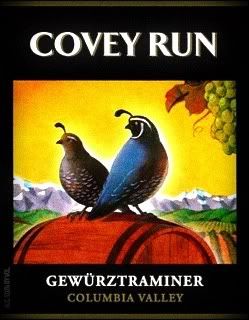
For spicy Asian food, I generally like to call for the Gewürztraminer. I also like it with duck, smoked salmon and cheeses, but its true calling seems to be as a mate for spicy foods. A recent visit to P.F. Chang's China Bistro in the Beverly Center in Los Angeles found me with a glass of a Washington State Gewürz in front of me, from Covey Run.
The Covey Run website states that they use "grapes grown in the Columbia and Yakima valleys, Washington State’s finest growing regions." For this Gewürztraminer, they continue, "Our Gewürztraminer vineyards are located in the cooler parts of Washington’s Yakima Valley, planted at higher elevations and even on northerly facing slopes. Gewürztraminer grown in these areas attains high sugar levels, spicy flavors and a lovely red skin color at harvest, much as it does in its native Alsace."
The 2008 vintage is 100% Columbia Valley AVA Gewurztraminer - earlier vintages featured slight traces of Muscat Canelli or Muscat Ottonel. The floral, fruity nose is immediately inviting, and flavors of peach and pear are joined by a good minerality and light acidity.
The wine paired reasonably well with the fried string beans but really showed its worth with the very spicy pork ribs.
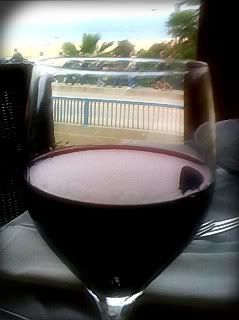
The Santa Monica restaurant called The Lobster is one of my favorite places for lunch in Southern California. The view looking out into the Pacific Ocean and over the Santa Monica Pier are reason enough, but the food's pretty good, too - and that's the understatement of the year.
I never seem to order lobster at its namesake eatery, largely because Denise generally does the honors in the crustacean department and I am always awarded a choice morsel or two from her plate - as long as I've been a good boy.
It can be rather cool along the beach, too, unless it's the heat of summer. Sometimes that cool ocean breeze puts me more in the mood for a red wine. Then, I look for a meal more suited for that choice.
The wine that caught my eye this time was a Garnacha from the San Alejandro vineyard in Calatayud, in the province of Zaragoza, Aragon, Spain. The Las Rocas Vinas Viejas is a rich ruby color with a big, jammy nose full of tar and black fruit. It doesn't taste as brooding as it smells, with strident blackberry and cassis flavors. It's $10 by the glass at The Lobster.
This wine paired perfectly with Tasmanian trout salmon in a Port reduction sauce on creamy polenta with browned Brussels sprouts.
For dessert, a little of Denise's lobster.
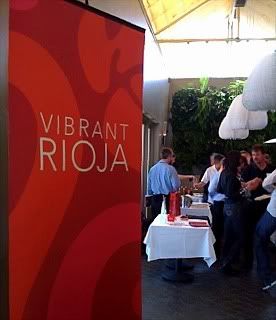
I wrote earlier about the Vibrant Rioja tasting event in Los Angeles, focusing on the Lopez de Heredia wines. Here are some of the other taste treats I discovered at the tasting.
Faustino had two wines I liked a lot. The Crianza '07 andReserva Cinco 2005 both show dense dark noses with earthy fruit. They taste just as rich as the nose leads me to believe they will. The Faustino Gran Reserva '98 is aging well and showing a trace of eucalyptus.
Big flavors came from the Beronia table. The '07 Tempranillo (100%), '07 Crianza of Tempranillo and Garnacha and the '06 Reserva of Tempranillo and Graciano offer big, mineral-driven cherry flavors. The '01 Gran Reserva shows more depth, having been aged three years in barrels and three years in bottles. It blends Tempranillo, Graciano and Mazuelo. Beronia's III a.C. '04 is described as a "Super Rioja," blending Tempranillo, Graciano and Mazuelo grapes. Pepper, leather and tobacco notes adorn the cherry fruit.
Antano's '09 Viura was one of my favorites, a nutty white with great acidity. The Conde de Valdemar Rosé impresses me quite a bit - one of the better $6 wines I've tried. CdV Inspiracion Valdemar 2007 shows a lovely bright cherry flavor. It's 100% Graciano.
Bodeagas Landaluce poured some great wines, in particular the Tempranillo with the mocha nose and the Capricho de Landaluce '05. The latter is all smokey and lush, and it's one of the more expensive wines at the event, with a $47 price tag.
Castillo Labastida's '08 Madurado is rustic and full of minerals, while their Reserva 2004 gives a nose and palate full of succulent black cherry.
Navarrsotillo's Noemus Rioja Blanco '09 makes a huge tropical play, Noemus Rioja Rosado '09 is a 100% Garnacha rosé and the Noemus Rioja Tinto '08 blends Tempranillo with Garnacha and Mazuelo. It has a huge fruit expression. All three of those wines deliver a lot for under $10 each. Spend a little more - $19 - for the Magister Bibendi Rioja Reserva 2005 and you get a great red wine with fantastic tannins and no bite.
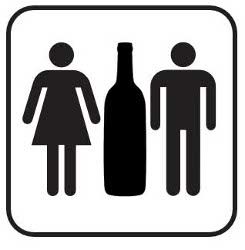
From Natalie MacLean's wine site, NatDecants, comes an article by Bill Ward in which he explores some of the differences between male and female behavior where wine is concerned.
Ward looks at wine through the eyes of both sexes, highlighting the often opposite attitudes on wine.
He quotes Ms. MacLean on how men and women approach wine. "Men are far more focused on the scores," she says, "and women on the stories behind the wines."
Wine merchant Kristen Kowalski supports that claim. She says men typically ask to purchase wines based on the scores they receive from wine critics, while women tend to ask about wines they've seen paired with a particular recipe or wines with which they have personal experience with, say, in a restaurant.
Ward also points out that women are much more likely than men to seek help when selecting a wine in a store or restaurant. Men prefer to do it on their own, even when they don't know what they are talking about. The article cites a British study which found that men tend to claim more knowledge about wine than they actually have.
Kowalski also offers that "Men seem to find a comfort zone and stay in it." She says men tend to be intimidated by imported wines where they may have trouble understanding the information on the labels.
Another retailer says when men find a wine they like, they are more apt to buy a case of it, while women seem to prefer buying mixed cases that offer more variety.
Men and women may look at wine differently, but one thing stays the same between the sexes - wine is definitely a pleasure.
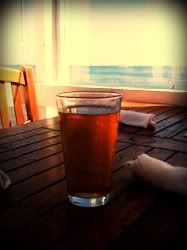
The calendar did not reflect it, but the weather didn't notice on a recent trip to The Beachcomber on the Malibu Pier. It looked and felt like summer to me, and I enjoyed a couple of summery beverages during a long lunch with the mom-in-law. Some may quip that lunch with a mother-in-law is always long, but she and I always get along just fine.
Kona Brewing Company's Longboard Island Lager got things off to a great start. It's really yellow, with a nice head, white and fluffy. The taste is very clean and the hops are fresh with a touch of malt and a citrus edge on the palate.
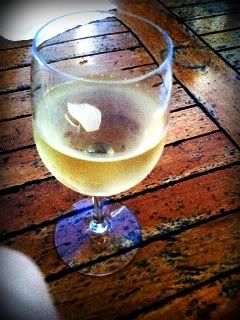 Service was quite slow, so another beverage seemed appropriate. I opted for an Edna Valley white wine I know and love, the Tangent Sauvignon Blanc. Grassy minerals and a nose full of citrus notes lead to a palate loaded with lemon zest and wet rocks. It pairs extremely well with sunshine and Mahi Mahi.
Service was quite slow, so another beverage seemed appropriate. I opted for an Edna Valley white wine I know and love, the Tangent Sauvignon Blanc. Grassy minerals and a nose full of citrus notes lead to a palate loaded with lemon zest and wet rocks. It pairs extremely well with sunshine and Mahi Mahi.
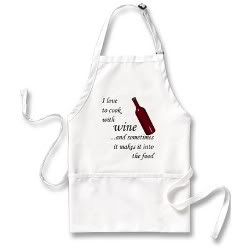
If you've ever had a wine butter compound at a restaurant - a mixture of butter and red wine - you know what a great tasting condiment this is, especially a dollop on top of a nice juicy steak.
I ran across a recipe for this concoction that you can easily make at home, from a fellow named Ben Carter, who goes by the name Benito on his Wine By Benito blog.
It sounds so easy even I could do it. All you need is a half a cup of red wine and a stick of unsalted butter.
Boil the wine slowly until it's like a syrup. Take care not to boil too long, or it will cake onto your pan. Mash the wine syrup into the butter until it is mixed well. It may take a little doing to accomplish this, and Benito advises an apron - like the one pictured - or some old clothes for this procedure.
When the butter is purple, put it on some wax paper and roll it into a log. Put it in the fridge and let it cool for six hours before serving.
You can experiment by adding some garlic, chives or sage into the mixture.
Bon appetit!

Russ Kane, in his great Vintage Texas Blog, has issued a plea to the government of the Lone Star State - "Don't forget about the Texas wine industry!"
Kane recounts how Texas Governor Rick Perry made a little wager with Virginia Governor Bob McDonnell on the outcome of the NCAA women's basketball championship game. McDonnell is a Notre Dame graduate, and Perry was backing the ladies from Texas A&M University.
Perry wagered a case of Texas wine - Viognier from Becker Vineyards - against a mixed case from Virginia's Barboursville Vineyards.
Kane points out that Governor Perry's current budget proposal calls for slashes to funding for the Texas wine industry. An investment of just over two million dollars, says Kane, has helped turn Texas wine into a $1.7 billion cash cow for the state. Kane - and many others - don't want to see that growth stopped in its tracks.
The article states that this funding is not a subsidy. The funds for research, marketing and education is money that is generated by the taxes on wine sales in Texas. Quoting Kane,
"The influx of dollars to the industry have helped to (1) identify the grape varieties best suited for the Texas soils and weather, (2) devise methods to handle vineyard diseases particular to Texas like Pierce’s Disease and Cotton Root Rot and (3) helped to investigate improved wine making techniques for the grapes that can grow in Texas. Most importantly, these funds have also gone to developing programs that are educating the vineyard and winery personnel critical to the new agricultural jobs in Texas."
The upshot is, according to Kane, that the Texas legislature is trying to save 2 million dollars a year by cutting the legs out from under a business that generated $78.5 million dollars in tax revenue for the state in 2009. That doesn't sound like good business to Kane, and it shouldn't sound like good business to anyone else.

This white wine comes from the Cheverny region of France's Loire Valley. Winemaking in Cheverny dates back as far as the sixth century, but the region is one of the newest appellations in the valley, attaining that status in 1991. French wine law states that all wines produced in Cheverny must be blends. Domaine Le Portail Proprietor Michel Cadoux and his clay-based soil produce a very nice blend of 80% Sauvignon Blanc and 20% Chardonnay. It's available by the glass at Le Clafoutis in West Hollywood's Sunset Plaza for just $8.
We had the best table in the house for lunch, right by the wide front doors. They had been swung into the open position to let in the sunlight and the cool breeze. Tables were available on the sidewalk just through those doors, but we were near enough to experience the outdoors with all the comfort of indoors.
That Cheverny Blanc has a nose with some light grass and herbal notes, with a strong aroma of minerals. On the palate there is plenty of fruit, along with flavors of green olive - Denise says it's Lucques olives - and a hint of capers. It was right on target with the chicken piccata and the chopped salad with chicken and beets.

Wines And Vines reported on a study done by Wine Opinions which found that high-frequency wine drinkers prefer consuming their favorite beverage at places other than the dinner table.
The report states that only 41 percent of the wine consumed in America is paired with a meal. 59 percent of it is consumed without food, while preparing a meal or with snacks. The amount of strictly solo wine drinking is 26 percent.
More figures are available in the report, which featured demographic and lifestyle breakdowns on wine consumption.
In what may come as a surprise to many, the stats showed that those high-frequency wine drinkers aren't all that concerned with food and wine pairings. Also, white wine is the go-to "cocktail" wine for only 25 percent of the respondents.
The high-frequency wine consumers in this study are defined as people who drink wine daily or several times per week. The daily wine drinkers accounted for 29 percent of the respondents, while 54 percent had a glass of wine several times weekly.
The biggest surprise of the report for me was that not even 30 percent of wine drinkers in America have a glass on a daily basis.
I have a glass of wine nightly, which has prompted some good-natured ribbing from my wife on occasion regarding what a "lush" I am. I don't feel that a glass a night puts me in Foster Brooks territory, but then I suppose that might depend on the size of the glass.

In her must-read wine law blog, On Reserve, Lindsey Zahn writes about the Comprehensive Alcohol Regulatory Effectiveness Act - known last year as H.R. 5034 - which is rearing its ugly head again this year as H.R. 1161. Zahn says this year's bill is identical to the second version of the proposed legislation introduced to the U.S. House of Representatives last year.
Zahn quotes the main sponsor of the bill, Republican Representative Jason Chaffetz of Utah, as saying that he goal of the Act is to recognize and reaffirm that alcohol is different from other consumer products, and that it should continue to be regulated by the states with unprecedented powers to regulate wine in interstate commerce.
There has been strong reaction from opponents of the bill. Democratic congressman Mike Thompson of California is quoted as saying, "The federal government has no business picking winners and losers in the wine, beer, and distilled spirits industry. Yet the Comprehensive Alcohol Regulatory Effectiveness Act would do just that by banning the direct shipment of wine and other forms of alcohol in the U.S."
The bill, according to Thompson, "would allow individual states to replace federal standards with their own, making it harder for out-of-state producers in California and elsewhere to comply with other states’ laws."
Many states already have antiquated alcohol laws on the books which serve to prop up what is known as the "three-tier system" of distribution, in which state-supported middlemen stand between wine producers and their desired products.
The Now And Zin Wine Country series keeps rolling across America, shedding a little light on wine producing areas somewhat lesser-known than California.
Minnesota - The North Star State - has been billed on the state's license plates as "The Land Of 10,000 Lakes." I'm told that lakes actually number closer to 12,000 in Minnesota, but who's counting? Apparently someone is, but let's just say there are way more lakes than vineyards in Minnesota.
We'll keep an eye on that, though, because the Minnesota grape industry has seen huge growth in recent years. The number of vineyards in the state doubled between 2003 and 2008. Even so, the state's grape and wine industries are still young. Minnesota's wine production in 2009 was ranked the eighth lowest in America, at just over 114,000 gallons.
It gets cold in Minnesota, so winemakers there rely largely on grape varieties that are hardy enough to survive the winters. French hybrids are popular, and the state has even created its own varieties like Edelweiss and St. Croix specifically for their cold weather durability. The University of Minnesota's oenology program came up with the Frontenac and Marquette grapes.
 Fieldstone Vineyards in Redwood Falls, Minnesota responded to my request for an entry in this series. Thanks to owner Charles M. Quast and owner/winemaker Mark Wedge, who provided me with a bottle of their Marquette wine to sample.
Fieldstone Vineyards in Redwood Falls, Minnesota responded to my request for an entry in this series. Thanks to owner Charles M. Quast and owner/winemaker Mark Wedge, who provided me with a bottle of their Marquette wine to sample.
Fieldstone is the state's largest 100% Minnesota-grown winery, and they use grapes from a network of Minnesota growers. The vineyards and winery are just two hours southwest of the Twin Cities and a couple of hours northeast of Sioux Falls, South Dakota. They utilize some of those hardy grapes like Frontenac, LaCrescent, St. Pepin and Marquette. Fieldstone was founded in 2003, at the beginning of a big growth in the state's wine industry. Their menu includes semi-sweet white wines made from LaCrescent, Frontenac, and Edelweiss and a semi-sweet Frontenac rosé. Their reds range from sweet to dry. The Marquette wine I sampled is dry.
The Fieldstone Marquette is a very dark colored wine, so dark I can hardly see through it. A grapey nose shows some herbal notes, too. The wine runs a bit hot at first, with a noticeable presence of alcohol. Decant - or just let it sit in the glass - for an hour or so, and things change dramatically. The grapiness just about goes away and a slight sense of tar joins the herbal bouquet. The tannins settle down, too, and the wine becomes silky smooth. It's very dry and a bit tart, with lots of minerality and a fair amount of acidity. After the time to open up, the Marquette's dark, sour blackberry flavor is really a delight.
If other wineries in Minnesota produce wines as interesting as the Fieldstone Vineyards Marquette, the state's small wine industry should be in for more big growth.
Follow Randy Fuller on Twitter

It was a Spanish wine tasting event that really got me started exploring wine years ago, and I am repeatedly drawn back to events which feature Spanish wines. The Vibrant Rioja tasting event of April 11, 2011 jumped onto my calendar instantly. It was held at Hatfield's Restaurant in Los Angeles.
The room was perhaps a little small for the gathering of 20 or so importers, all pouring a number of wines at their tables. Space was extremely limited and enthusiastic wine dealers, sommeliers and writers jammed the dining area for the afternoon event.
Great wines abounded, and I'll cover some of them in another post. Today I want to concentrate on my favorite table of the event, the one that was so crowded the whole afternoon I could hardly edge myself in for a few tastes. That would be the table where the wines of Lopez de Heredia were poured.
Lopez de Heredia was founded in 1877 and is a Rioja institution, still owned and operated by the same family. They are particularly proud of their Tondonia Vineyard on the right bank of Ebro River, around which the Rioja region is drawn. Heredia also has three other vineyards, also in Rioja Alta - Cubillo, Bosconia and Zaconia.
The winery is known as much for white wines as for red, maybe more so. They age their whites and rosés in much the same manner the reds are aged, and they stand as a testament to age-worthy whites. White, pink or red, this is what old-world wine is all about.
Heredia's Viña Gravonia 2000 Crianza is a white wine made from 100% Viura grapes. This golden treat is tasting great, with a smokey and nutty taste. It's nice and dry with great acidity.
Viña Tondonia Rosado Gran Reserva 2000 - This brownish peach-colored rosé is a blend of 60% Garnacha, 30% Tempranillo and 10% Viura. The unusual, smokey nose leads to a palate decorated with a nutty strawberry flavor.
Viña Cubillo Crianza 2005 - A red blend of 65% Tempranillo, 25% Garnacha and some Graciano and Mazuelo filling out the rest, this wine offers a hint of anise on the nose and rustic, earthy cherry flavors.
Viña Bosconia Reserva 2002 - Smooth, dusty cherry aromas and flavors dominate this blend of 80% Tempranillo, 15% Garnacha and Graciano and Mazuelo. It's aged in French oak for five years.
Viña Tondonia Tinto Gran Reserva 1991 - Heredia says 1991 was one of the best vintages in the history of the Tondonia Vineyard, and this wine bears out that claim. Toasted vanilla notes and a full mouthfeel are featured in this very dry Tempranillo/Garnacha blend filled out with Graciano and Mazuelo grapes. Aged in barrels for nine years, this wine is old-world elegance defined.
Viña Ijalba Graciano 2007 - Amanda Linn of WineWise was also pouring this new-world style, almost as an afterthought. Its extreme fruitiness was delicious and served as an excellent counterpoint to the Heredia old-world style.

A recent article in The Wine Economist explored a question that's always on the minds of those interested in wine - what's the next big thing? Figures cited in the story - taken from another article in Wine Business Monthly - show that sales of Moscato wines increased by about 91% during 2010, when overall wines sales only grew by just under five percent.
The Wine Economist speculated that some White Zinfandel drinkers may be moving over to Moscato, as sales of White Zin have fallen off a bit. The originator of White Zinfandel - Sutter Home - produces a Moscato Alexandria, while the article also cites Moscato entries from Robert Mondavi Woodbridge, Barefoot Cellars, Columbia Crest and other wineries.
In the comments to the article, a reader suggested much of Mocasto's newfound popularity may be due to hip-hop artist Drake, who sang about the grape variety in his 2009 single called "Do It Now," in which he raps for "lobster, shrimp and a glass of Moscato."
Popular culture has certainly affected the wine industry before. Rapper Jay-Z put an obscure Champagne by the name of Armand de Brignac on the map when he featured it in his 2006 video for the song, "Show Me What You Got." Now, reportedly, the French producer can't make enough of it.
The 2004 film "Sideways" was credited - or blamed - for ruining the market for Merlot. One of the movie's characters had a decided bias against that particular grape, preferring Pinot Noir. Sales of Pinot Noir went up in the "Sideways" aftermath.

The numbers are out, and Americans can give a big "We're number one!" cheer, because in 20-10 the U.S. surpassed France as the nation consuming the most wine in the world. According to Wine Institute, the tally came to 330 million cases, up two percent from the previous year and a record high for the industry. All that wine is said to be worth $30 billion, and that number is four percent higher than 2009.
What kind of California wines are we drinking in such great quantities? The report went on to show 53 million of those cases were California Chardonnay, while 33 million cases were Cabernet Sauvignon from the Golden State. California Pinot Noir, Zinfandel, Riesling and Muscat also showed an uptick in consumption.
Some of us may have been celebrating our new status early, as U.S. consumption of sparkling wine and Champagne was up ten percent, to 15.4 million cases.
 Niner was awarded the LEED Silver Certification for its Paso Robles complex, which includes a Hospitality Center, Demonstration Winery and Production Winery totalling about 75,000 square feet on 140 acres of Westside real estate.
Niner was awarded the LEED Silver Certification for its Paso Robles complex, which includes a Hospitality Center, Demonstration Winery and Production Winery totalling about 75,000 square feet on 140 acres of Westside real estate. A tour of the facility showed the different facets which allowed Niner to achieve the honor. Niner's enologist, Lorna Kreutz, guided me through the entire Production Winery. She took it all in stride, but I was agog at the pristine conditions I found in the tank room. I guessed that since the place is fairly new, it just hadn't had time to take on a "lived-in" look. "No," said Lorna, "we work pretty hard to keep it looking nice." I spied what looked like a couple of scraps of paper on the floor, but I was wrong again. "Those are actually pieces of tape placed there for measurement purposes," she said. "When the crew is done working, they'll take those up."
A tour of the facility showed the different facets which allowed Niner to achieve the honor. Niner's enologist, Lorna Kreutz, guided me through the entire Production Winery. She took it all in stride, but I was agog at the pristine conditions I found in the tank room. I guessed that since the place is fairly new, it just hadn't had time to take on a "lived-in" look. "No," said Lorna, "we work pretty hard to keep it looking nice." I spied what looked like a couple of scraps of paper on the floor, but I was wrong again. "Those are actually pieces of tape placed there for measurement purposes," she said. "When the crew is done working, they'll take those up." Niner was awarded the LEED Silver Certification for its Paso Robles complex, which includes a Hospitality Center, Demonstration Winery and Production Winery totalling about 75,000 square feet on 140 acres of Westside real estate.
Niner was awarded the LEED Silver Certification for its Paso Robles complex, which includes a Hospitality Center, Demonstration Winery and Production Winery totalling about 75,000 square feet on 140 acres of Westside real estate. A tour of the facility showed the different facets which allowed Niner to achieve the honor. Niner's enologist, Lorna Kreutz, guided me through the entire Production Winery. She took it all in stride, but I was agog at the pristine conditions I found in the tank room. I guessed that since the place is fairly new, it just hadn't had time to take on a "lived-in" look. "No," said Lorna, "we work pretty hard to keep it looking nice." I spied what looked like a couple of scraps of paper on the floor, but I was wrong again. "Those are actually pieces of tape placed there for measurement purposes," she said. "When the crew is done working, they'll take those up."
A tour of the facility showed the different facets which allowed Niner to achieve the honor. Niner's enologist, Lorna Kreutz, guided me through the entire Production Winery. She took it all in stride, but I was agog at the pristine conditions I found in the tank room. I guessed that since the place is fairly new, it just hadn't had time to take on a "lived-in" look. "No," said Lorna, "we work pretty hard to keep it looking nice." I spied what looked like a couple of scraps of paper on the floor, but I was wrong again. "Those are actually pieces of tape placed there for measurement purposes," she said. "When the crew is done working, they'll take those up."


 The thing is, you don't have to ask. Karl Wittstrom has all this information ready to spill forth anytime someone looks interested, which I suppose I did.
The thing is, you don't have to ask. Karl Wittstrom has all this information ready to spill forth anytime someone looks interested, which I suppose I did. The vineyard features five distinct soil types: ancient sea bed, sedimentary, shale, volcanic and granitic. The folks at Ancient Peaks feel these different soil types bring added dimension and complexity to their wines. Wittstrom delighted in showing off the ancient oyster shells which are imbedded in outcroppings and even scattered about the hillsides of the vineyard.
The vineyard features five distinct soil types: ancient sea bed, sedimentary, shale, volcanic and granitic. The folks at Ancient Peaks feel these different soil types bring added dimension and complexity to their wines. Wittstrom delighted in showing off the ancient oyster shells which are imbedded in outcroppings and even scattered about the hillsides of the vineyard. Sauvignon Blanc 2010 - Grapes from the cool-climate Margarita Vineyard are augmented by a bit of fruit from San Juan Vineyard, in the eastern portion of the Paso Robles AVA. Grass and minerals dominate the expressive nose and the steel-fermented wine is crisp and refreshing with a very nice acidity.
Sauvignon Blanc 2010 - Grapes from the cool-climate Margarita Vineyard are augmented by a bit of fruit from San Juan Vineyard, in the eastern portion of the Paso Robles AVA. Grass and minerals dominate the expressive nose and the steel-fermented wine is crisp and refreshing with a very nice acidity.

 Over two dozen wineries of the Paso Robles AVA are expected to turn out. Names like Cass, Terry Hoage, Hope Family Wines, Turley, Niner and Villa Creek will be joined by hidden gems Roxo Port, Lone Madrone, Alta Colina and Bodegas Paso Robles.
Over two dozen wineries of the Paso Robles AVA are expected to turn out. Names like Cass, Terry Hoage, Hope Family Wines, Turley, Niner and Villa Creek will be joined by hidden gems Roxo Port, Lone Madrone, Alta Colina and Bodegas Paso Robles.
 Where To Stay
Where To Stay One tasting room is interesting in that it serves as a tasting room for six of the smaller local wineries. The
One tasting room is interesting in that it serves as a tasting room for six of the smaller local wineries. The




 Service was quite slow, so another beverage seemed appropriate. I opted for an Edna Valley white wine I know and love, the
Service was quite slow, so another beverage seemed appropriate. I opted for an Edna Valley white wine I know and love, the 




 Fieldstone Vineyards
Fieldstone Vineyards
